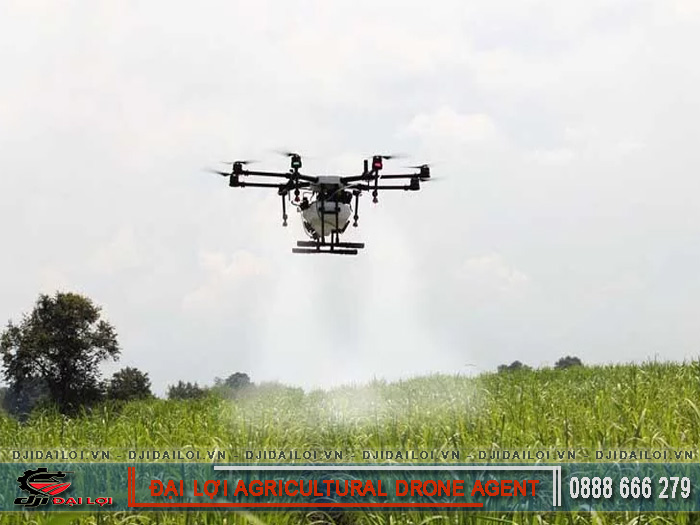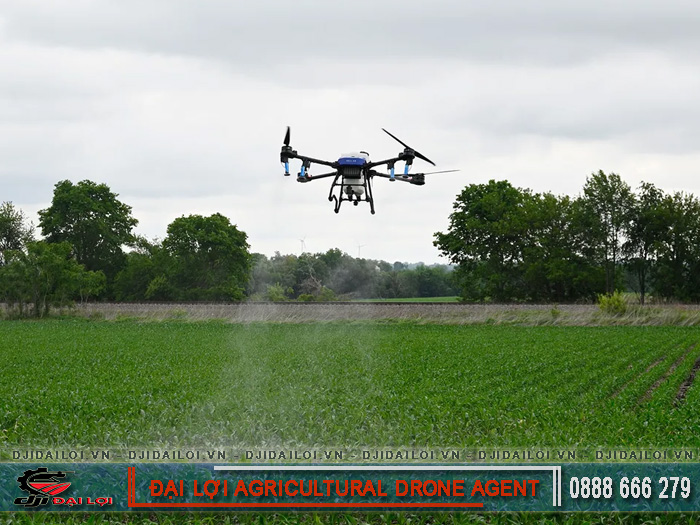
A pesticide-spraying drone is an unmanned aerial vehicle (UAV) equipped with an automatic spraying system to distribute pesticides or liquid fertilizers over crops. It operates using sensors, GPS positioning, and a central control system that enables precise flight paths.
This agricultural drone applies automation technology to spray pesticides accurately, reducing labor requirements and minimizing environmental pollution.
How the system works:
|
Criteria |
Manual Spraying |
Pesticide-Spraying Drone |
|---|---|---|
|
Efficiency |
0.5-1 ha/hour |
5-10 ha/hour |
|
Accuracy |
Depends on operator skill |
GPS positioning ±5 cm |
|
Labor cost |
High, multiple workers needed |
Low, one operator only |
|
Health safety |
Direct exposure to chemicals |
Minimal exposure |
|
Chemical usage |
Often wasteful |
Saves 20-30% |
→ Switching to agricultural spraying drones helps optimize farming operations and improve worker safety, especially in rice and fruit cultivation areas.
The total upfront cost of a spraying drone ranges from VND 80-300 million, depending on capacity and brand. In addition to the drone itself, users should factor in spare batteries, nozzles, fast chargers, additional tanks, and mapping software. Choosing the right model for your farm size helps optimize long-term investment costs.
A typical drone battery allows 15-25 minutes of operation, covering 2-3 hectares per charge. Performance depends on nozzle type, pesticide viscosity, and flight speed.
Battery-saving checklist:
One drone can replace 5-10 manual workers. For a 10-hectare area, one operator and two spare batteries are enough for a full working session. The saved time allows farmers to spray at the optimal crop growth stage for better pest control.
To keep drones running efficiently, perform maintenance every 3-6 months, including:
Proper maintenance can extend the drone’s lifespan and reduce repair costs by 15-20% annually.
Before investing, determine your farm area, crop type, and spraying frequency to choose a suitable configuration. For small fields, use 10-16L drones; for farms over 3 hectares, choose high-capacity agricultural drones.
Ideal flight speed is 4-6 m/s, at 2-3 m above the canopy. Spray 10-15L/ha for rice, and 20-25L/ha for fruit trees. Correct adjustment saves pesticides and protects the environment.
Avoid flying in winds above level 4, rain, or thunderstorms. For sloped or uneven fields, fly along the contour lines to reduce tilting risks.
Use mapping software such as DJI Terra to define boundaries, altitude, wind direction, and no-fly zones. This ensures accurate spraying with no overlaps or missed spots.
Perform 1-2 trial flights to fine-tune speed, pressure, and spray volume. Calibration prevents errors during large-scale spraying, saving chemicals and improving accuracy.
Operators should wear protective clothing, masks, and gloves. Avoid standing upwind of the spraying area. After spraying, clean the tank and nozzles with water to prevent residue buildup.
After each season:
Proper care ensures consistent drone performance across multiple seasons.
Select formulations with high adhesion and diffusion capacity to cut spraying volume by 20-30%. Use drone-specific pesticide solutions with fine particles to avoid nozzle blockage. This is one of the most effective ways to save spraying costs while increasing yield and reducing pollution.
Batteries account for over 30% of operational costs. To maximize battery life:
Proper care can extend battery life by 40-50% and reduce annual replacement costs.
Modern agricultural drones support automated GPS-guided flight. This mode adjusts altitude, flight path, and spray volume automatically-reducing chemical waste and overlap. It’s especially beneficial for beginners, helping lower costs while maintaining precision.
A growing trend is group investment-several farmers jointly purchase and share drone usage by schedule or area. This model reduces individual investment costs and maximizes drone utilization.
For small farms or infrequent spraying, hiring a professional drone spraying service is more economical. Service providers use modern equipment and trained pilots, helping farmers save more compared to owning a drone outright.

This often occurs when using thick or residue-heavy solutions. To fix it:
→ To clear a blocked nozzle, stop flying, clean it with warm water, and inspect the filter before resuming.
Signal loss often results from GPS interference or low battery. To handle it:
If the issue persists, recalibrate the IMU and compass sensors to stabilize flight paths.
After each spraying season:
Regular inspections ensure high spraying accuracy and reduce operational errors.
|
Criteria |
Manual Spraying |
Pesticide-Spraying Drone |
|---|---|---|
|
Productivity |
1 ha/day |
10-15 ha/day |
|
Chemical usage |
High, wasteful |
Saves 20-30% |
|
Labor cost |
500,000-700,000 VND/day |
Almost none |
|
Spray uniformity |
Inconsistent |
Very consistent |
|
Health risk |
Possible poisoning |
Safe for operators |
→ Using a pesticide-spraying drone increases productivity tenfold, reduces chemical costs by 25%, and minimizes health risks for farmers.
On average, for a 20-hectare farm, the payback period for a spraying drone is 8-10 months. If used for service spraying, net profits can reach 15-20 million VND per month after expenses.
Many localities have established agricultural cooperatives that jointly invest in spraying drones, share usage schedules, and manage maintenance collectively. This model can cut personal investment costs by up to 60% compared to individual purchases.
The DJI Agras series is known for precise spraying, fuel efficiency, and multi-directional radar sensors that enable stable flight in complex terrain. Each model is optimized for different farming scales-from smallholders to large farms.
|
Model |
Tank Capacity |
Spraying Efficiency |
Suitable Area |
Key Features |
|---|---|---|---|---|
|
T10 |
10 L |
6 ha/hour |
<1 ha |
Compact, easy to control |
|
T20P |
20 L |
10 ha/hour |
2-5 ha |
Dual radar, HD camera |
|
T50 |
50 L |
20 ha/hour |
>5 ha |
High power, battery efficient |
|
T70P |
70 L |
30 ha/hour |
>10 ha |
Fully automated, maximum efficiency |
⇒ When operated correctly, pesticide-spraying drone not only reduce spraying costs but also drive modern farming practices-advancing toward a smart, sustainable, and efficient agriculture future.